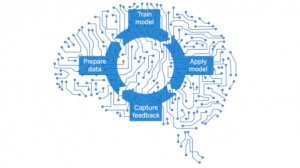Machine learning is the sub field of computer science that, gives “computers the ability to learn without being explicitly programmed.” Evolved from the study of pattern recognition and computational learning theory in artificial intelligence, machine learning explores the study and construction of algorithms that can learn from and make predictions on data – such algorithms overcome following strictly static program instructions by making data-driven predictions or decisions, through building a model from sample inputs. Machine learning is employed in a range of computing tasks where designing and programming explicit algorithms with good performance is difficult or unfeasible; example applications include email filtering, detection of network intruders or malicious insiders working towards a data breach, optical character recognition (OCR), learning to rank and computer vision.

Machine learning is closely related to (and often overlaps with) computational statistics, which also focuses on prediction-making through the use of computers. It has strong ties to mathematical optimization, which delivers methods, theory and application domains to the field. Machine learning is sometimes conflated with data mining, where the latter sub field focuses more on exploratory data analysis and is known as unsupervised learning. Machine learning can also be unsupervised and be used to learn and establish baseline behavioral profiles for various entities and then used to find meaningful anomalies.
Within the field of data analytics, machine learning is a method used to devise complex models and algorithms that lend themselves to prediction; in commercial use, this is known as predictive analytics. These analytical models allow researchers, data scientists, engineers, and analysts to “produce reliable, repeatable decisions and results” and uncover “hidden insights” through learning from historical relationships and trends in the data.
As of 2016, machine learning is a buzzword, and according to the Gartner hype cycle of 2016, at its peak of inflated expectations. Because finding patterns is hard, often not enough training data is available, and also because of the high expectations it often fails to deliver.
Types of Problems and Tasks:
Machine learning tasks are typically classified into three broad categories, depending on the nature of the learning “signal” or “feedback” available to a learning system. These are
- Supervised learning: The computer is presented with example inputs and their desired outputs, given by a “teacher”, and the goal is to learn a general rule that maps inputs to outputs.
- Unsupervised learning: No labels are given to the learning algorithm, leaving it on its own to find structure in its input. Unsupervised learning can be a goal in itself (discovering hidden patterns in data) or a means towards an end (feature learning).
- Reinforcement learning: A computer program interacts with a dynamic environment in which it must perform a certain goal (such as driving a vehicle or playing a game against an opponent). The program is provided feedback in terms of rewards and punishments as it navigates its problem space.
Between supervised and unsupervised learning is semi-supervised learning, where the teacher gives an incomplete training signal: a training set with some (often many) of the target outputs missing. Transduction is a special case of this principle where the entire set of problem instances is known at learning time, except that part of the targets are missing.
Among other categories of machine learning problems, learning to learn learns its own inductive bias based on previous experience. Developmental learning, elaborated for robot learning, generates its own sequences (also called curriculum) of learning situations to cumulatively acquire repertoires of novel skills through autonomous self-exploration and social interaction with human teachers and using guidance mechanisms such as active learning, maturation, motor synergies, and imitation.
Another categorization of machine learning tasks arises when one considers the desired output of a machine-learned system:
- In classification, inputs are divided into two or more classes, and the learner must produce a model that assigns unseen inputs to one or more (multi-label classification) of these classes. This is typically tackled in a supervised way. Spam filtering is an example of classification, where the inputs are email (or other) messages and the classes are “spam” and “not spam”.
- In regression, also a supervised problem, the outputs are continuous rather than discrete.
- In clustering, a set of inputs is to be divided into groups. Unlike in classification, the groups are not known beforehand, making this typically an unsupervised task.
- Density estimation finds the distribution of inputs in some space.
- Dimensionality reduction simplifies inputs by mapping them into a lower-dimensional space. Topic modeling is a related problem, where a program is given a list of human language documents and is tasked to find out which documents cover similar topics.
The Above mentioned is a brief about Machine Learning. Watch this space for More Information on the Latest trends in Technology.

